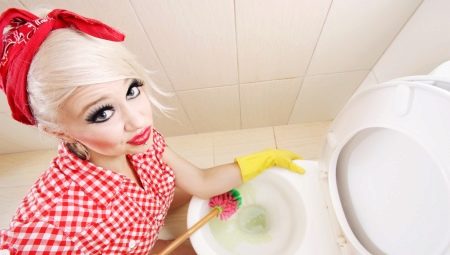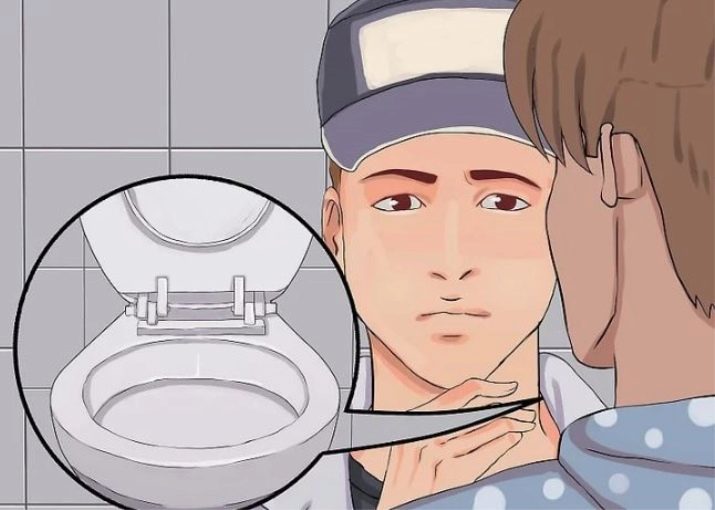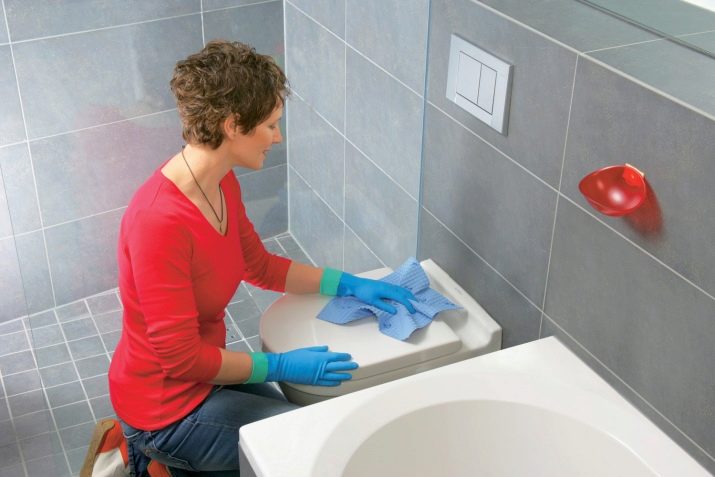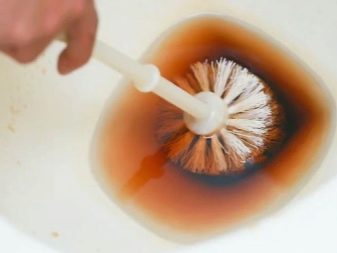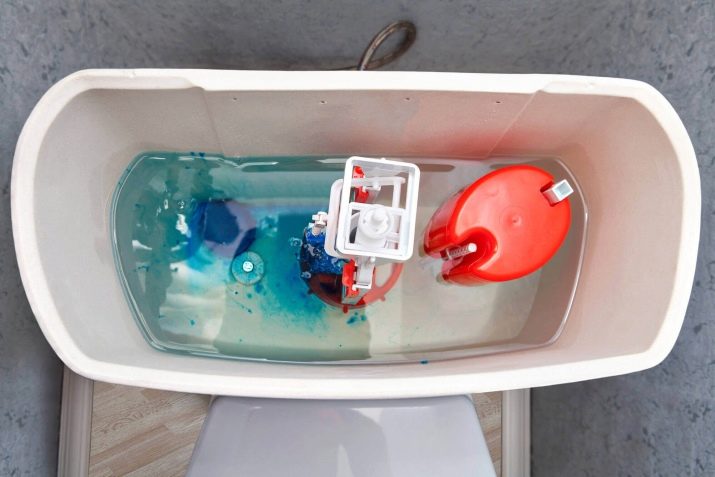Every self-respecting hostess keeps the bathroom clean, carefully removing rust stains and limescale from the toilet. It often takes a lot of time for this painstaking business, and therefore it’s time to learn how to clean the toilet from rust and plaque quickly and for a long time, saving time for more pleasant troubles.
Causes of rust and lime
You must admit that each of us has a dirty toilet, and most often we ourselves are to blame for its neglect. The main causes of stains and smudges:
- water quality;
- old pipes;
- malfunction and constant flow of the tank;
- high level of roughness of the toilet bowl;
- lack of water-repellent coating;
- large amounts of calcium salt in water;
- untidiness of households.
Rust and lime deposits have various causes. So, excessively hard water with an excess of iron necessarily causes traces. This situation will be aggravated if the tank leaks. And if an excess of iron leads to rust, then excess calcium salt in the water will certainly lead to a limescale accumulated at the rim of the toilet bowl.
However, the acquisition of the toilet bowl itself may already cause the rapid appearance of stains. A rough version without a water-repellent coating and improper cleaning quickly lead to scratches and clogging of dirt, rust and lime in them. The reason, which lies in the uncleanliness of the household, can gradually lead to serious and difficult to remove stains from urinary stone.
It is possible to avoid its appearance if you introduce into the family the habit of flushing after you after each trip to the toilet or pouring out the pot by the children.
Cleansing methods
Any contamination on the toilet is important to clean and clean as soon as possible. The fact is that it is very difficult to wipe off the rust that has been eaten, without damaging the bathroom. Cleansing at home can occur a variety of methods, most of which are the most accessible and effective.
Household chemicals
In the proposed means for cleaning toilets today it is easy to get confused, confused in the widest range. In fact, each of them belongs to one of the four groups created on the basis of differences in composition. Types of agents to combat lime and rust:
- alkaline;
- powder;
- acid-based;
- based on chlorine.
It is recommended to give preference to gel and balsam textures.. They are able to provide not only high-quality, but also safe cleaning without damaging the toilet bowl cover. Alkaline products include all products from plaque and rust stains, created on the basis of sodium. They are considered to be completely safe means of ease of use and a high degree of efficiency. Among the famous brands stand out products "Dosya" and "Bref".
Powder formulations are among the strongest in their actions. So, they are practically the only ones who can cope with urinary stone. Using a stiff brush, the powder is rubbed into the surface, on the one hand removing difficult stains, and on the other - creating microcracks for future accumulation of dirt. That is why such drugs as Pemolux and Flash It is worth using only in extreme cases. Products based on chlorine are also suitable for removing stains from the toilet with their own hands.Inflicting it from the inside, you can see how the plaque literally creeps down and the surface is disinfected.
Unfortunately, bleach and chlorine-containing products have a strong odor, which causes some users to turn to advanced products. This category includes funds "Comets" and "Silite".
Means based on oxalic, formic, hydrochloric and other acids are not inferior in the purification of bleach. Such products as "Santri "or" Dressing duckling " do not have strong odors, but with long-term use can adversely affect human health. To use such products should be periodically, not forgetting the prohibition of its use when washing faience and ceramic toilets.
Folk remedies
As you can see, most of the ready-made cleaning products have certain limitations in their use. Some housewives avoid such difficulties consciously applying in cleaning only folk sparing means:
- So, one of the popular washing methods is iodine solution with vinegar. A small container is filled with vinegar, a few drops of iodine and a pinch of soda. The solution is thoroughly mixed and applied to the surface to be cleaned for 6-8 hours, and then washed off with clean water;
- An interesting and popular method is pouring into the toilet or Coca-Cola toilet flush. Yes, it is the drink that, without exception, all children love. Leaving the solution overnight, in the morning the bathroom is rinsed with water;
- according to the same principle, citric acid and soda are used in purification. This or that product is poured onto the contaminated surface and left to work overnight. In the morning, rinse off the product with water or rinse thoroughly if cleaning occurs from inside the tank;
- hydrogen peroxide in tandem with liquid ammonia can be a good alternative to products from the store. The proportion is 5 ml of ammonia per 100 ml of peroxide. The solution is qualitatively applied to the surface and kept for about half an hour, then cleaned with a brush of medium softness and washed off.
It is worth noting that folk methods also have acids in their compositions. Thus, oxalic and hydrochloric acids can be used for cleaning in pure form. As mentioned earlier, the method is not the safest, and therefore it is important to work beforehand with strong gloves and a respirator. Inhaling these compounds is extremely harmful.
I must say that ready-made and folk remedies are equally effective, however, those who want to get quick results, still apply to purchased products, because hardly any of them requires upholding at night.
How to prevent rust and plaque?
The appearance of rust can and should be prevented, especially as it is not difficult to do. So, first of all, the owners of the apartment should adjust the float of the toilet and completely eliminate the constantly running thin stream of water. Even hard water with a regulated bathroom will have a much lesser degree of influence on the appearance of rust and limescale. It is worth noting that Replacing old, rusty pipes will also help fill the drain tank with clean water without unnecessary impurities.
Unfortunately, not everybody decides to make such a laborious step, but if it is carried out, the result pays for all the time and financial costs.
If the replacement of pipes is still not included in the plans, softening tablets, which are located inside the tank daily, will help to improve the condition of the water. In addition, such products envelops the bathroom with pleasant aromas, which plays an important role. A more capital method is considered the installation of a water filter in the drain structure. It is not cheap, but the cleaning of water in its application ceases to be a daily procedure with the participation of a housewife.
Sometimes, even with all the recommendations and preventive measures, the bathroom continues to quickly accumulate rust and deposits.Most likely, the problem here lies in the wrong cleaning once in the past, because a stiff brush can already thoroughly spoil the coating for several applications. If scratches are noticeable to the naked eye, the best solution would be to replace the plumbing and carefully follow the rules for cleaning it. Quality toilet cover, untouched by potent agents, is able to serve, pleasing with purity and aesthetics, for more than a decade.
For more information on how to quickly and effectively clean the toilet, see the following video.
